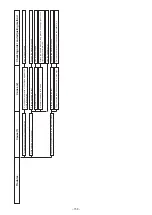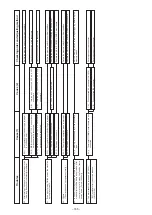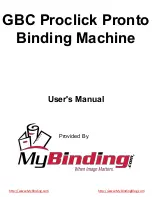
– 157 –
Troubles
Cause (1)
Cause (2)
Checking order and adjusting method
7. Poor tense stitches
8. Defective stitches with the synthetic thread
Defective adjustment of the tension controller No.
2
Tension controller No. 2 is floating.
Thread take-up spring is maladjusted.
Clearance between the inner hook and the shuttle
driver is defective.
Selection of the needle to be used is improper.
Selection of the needle hole guide is improper.
Shape of the feed plate is defective.
Feed timing is defective.
Thread breakage due to heat
Thread makes burrs.
Tension of the tension controller No. 2 is low.
Clearance between the inner hook and the shuttle
driver is small.
Needle to be used is thin.
Hole diameter of the needle hole guide to the
needle to be used and thread is small.
Material to be sewn is stiff and closely comes in
contact with the throat plate, and there is no
clearance between them to pass the thread.
Material to be sewn is highly elastic and closely
comes in contact with the throat plate, and there
is no clearance between them to pass the thread.
Feed timing is too fast.
Sewing speed is too fast.
Needle is too thick.
Thread path is defective.
Finish of needle eyelet is defective.
Needle thread loop falls down.
Properly adjust the tension of tension controller No. 2.
Properly adjust the thread release mechanism.
Properly adjust the tension and stroke of thread take-up spring.
Properly adjust the clearance between the inner hook and the
shuttle driver.
Replace the needle with a thicker one.
Replace the needle hole guide with a new one having a larger
needle hole diameter.
Raise the material to be sewn by means of the feed plate.
Raise the material to be sewn by means of the feed plate.
Change the feed timing using the memory switch.
Decrease the maximum speed.
Use a thinner needle or a super needle for the synthetic thread.
Apply silicon.
Use the needle cooler.
Polish the thread path of each component with polishing powder.
Replace the needle.
Move the thread guide A to the left.
















































